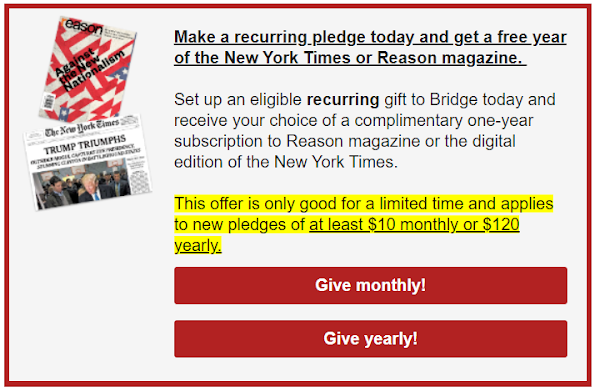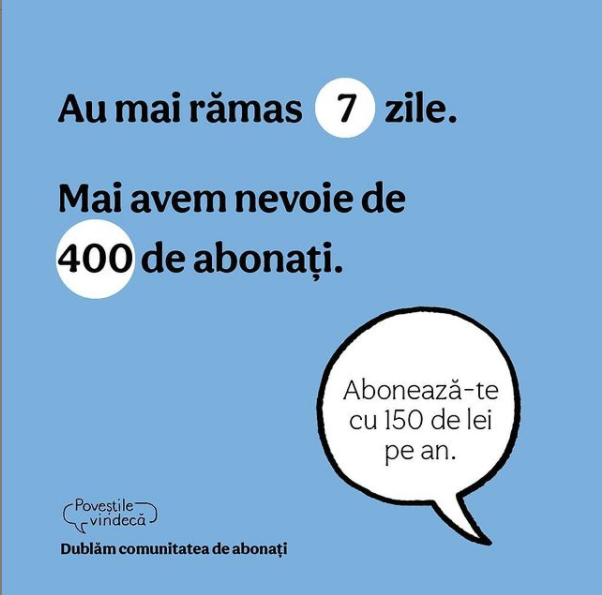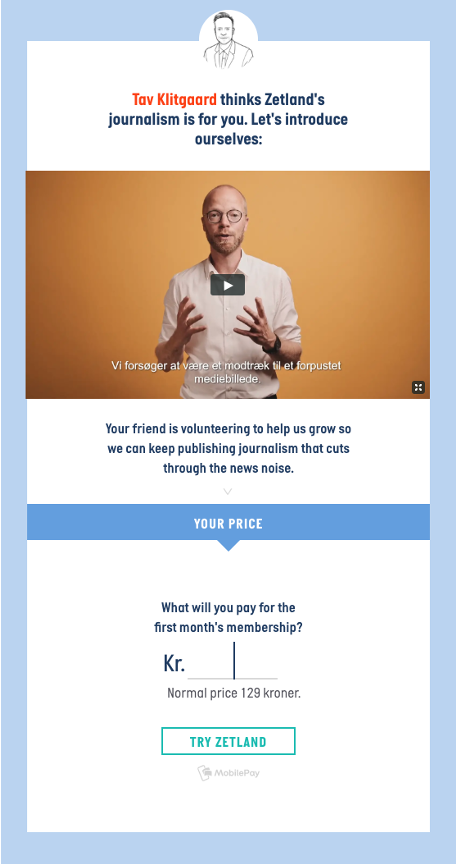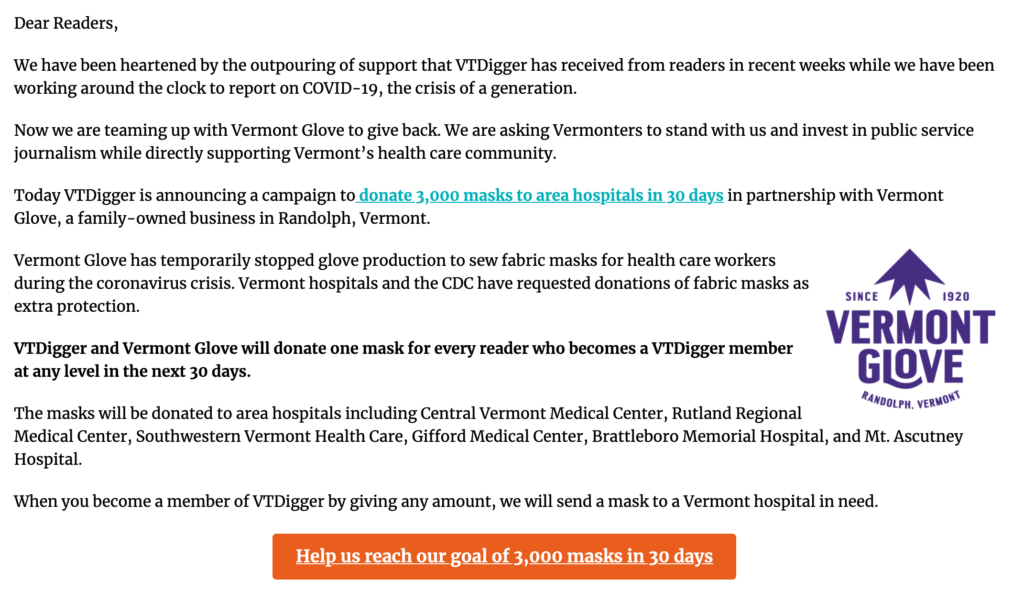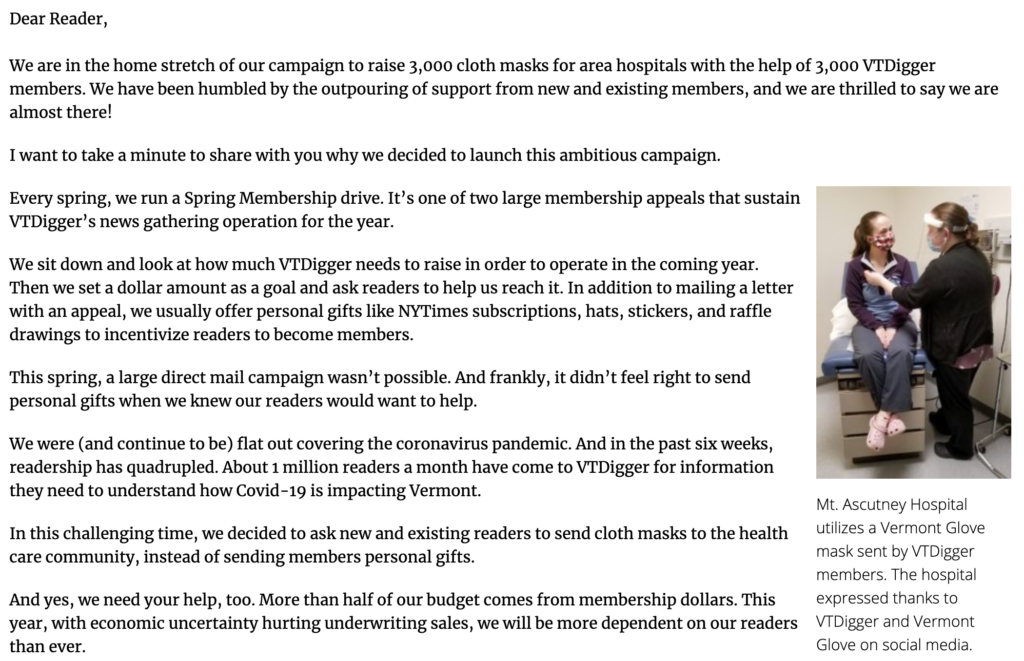Newsroom overview
A nonprofit, non-partisan, and digital-only newsroom dedicated to in-depth news and reporting on public policy, government, and politics in Connecticut
Hartford, Connecticut
2010
2019
~ 250,000
1,950
10 percent
Each year, as the Connecticut legislative session comes to a close, The Connecticut Mirror (which also goes by CT Mirror) kicks off one of its biggest and most successful annual fundraisers: The Gavel Give.
The Gavel Give is an aggressive 36-hour-long fundraising event that coincides with the end of the state’s legislative session. Although the timing of The Gavel Give changes slightly each year, the concept stays the same. The CT Mirror, with a 20-person staff dedicated to reporting on public policy, government and politics, uses the opportunity to remind readers about the value of their work and asks them over and over again to support future legislative reporting. The first time they ran Gavel Give in 2021, they raised about $32,000. In 2022, they raised about $39,000.
Why this is important
The final days of Connecticut’s legislative session mark a time when CT Mirror publishes dozens more stories and sees almost twice as many visitors than usual. Kyle Constable, CT Mirror’s director of membership and digital innovation, said they decided to “channel the natural energy” that comes from the annual event and turn it into a fundraising opportunity.
Most newsrooms have similarly predictable moments of elevated audience attention. Gavel Give offers a replicable way that other small and medium-sized newsrooms can leverage intense spikes in audience interest — not just once, but repeatedly, as CT Mirror has.
This case is particularly useful for newsrooms without dedicated membership staff. It can be hard to sustain a weeks-long membership campaign on a tiny team while still maintaining editorial operations, but reorienting staff around a 36-hour membership sprint might be more feasible.
What they did
Because Gavel Give happens almost exclusively over email, preparation begins months ahead of time with an effort to grow their email list. Each year, as part of a sprint with News Revenue Hub, Constable tests and updates CT Mirror’s newsletter sign-up calls to action on their website, including tweaking the language, location, and design of CTAs. “We want something that looks and feels different each year,” Constable explained. These small changes have a big impact: Their newsletter subscribers continue to grow, despite the fact that they regularly clean out inactive users.
CT Mirror has three core newsletters — their daily morning briefing, daily afternoon briefing, and weekly Sunday roundup — with around 15,000; 13,000; and 16,000 subscribers, respectively. They send all campaign emails to anyone who is signed up for any of their newsletters.
A match from a major donor is another key component of the campaign. A few months ahead of the inaugural Gavel Give, CT Mirror’s publisher reached out to one of the organization’s biggest donors for support. “We asked for a triple match,” Constable said, “because we really wanted to make this a notable event.” The donor agreed, and returned in 2022 to offer the same triple-match contribution.
Constable does as much work on the campaign ahead of time as possible, including designing, writing and scheduling countdown emails, and creating graphics that can be easily replicated and updated.
Their first campaign outreach for 2022 went out a few days before the fundraiser: a countdown postcard to their readers announcing their goal: to raise $36,000 in 36 hours. Forty-eight hours before kickoff, they sent a reminder email. They sent another reminder 24 hours ahead of the campaign.
The first official campaign email went at noon on Day 1 of Gavel Give. Over two days, CT Mirror sent eight fundraising emails, including appeals from reporters and editors, and updates on campaign progress. They also let readers know that all Gavel Give donations would be triple matched by an anonymous donor, something that added to the urgency of the event. Each of those emails (including the 100% email, which netted roughly another $1,000) brought in additional donations from readers.
Here’s a breakdown of the emails:
- Email 1:
- Sent: Monday, May 2 at 12 p.m.
- Subject line: The Gavel Give starts in 48 hours!
- Content: A static image reminder that the campaign starts in two days
- Email 2:
- Sent: Tuesday, May 3 at 12 p.m.
- Subject line: 24 hours until The Gavel Give begins!
- Content: A static image reminder that the campaign starts in one day
- Email 3:
- Sent: Wednesday, May 4 at 12 p.m.
- Subject line: The Gavel Give STARTS NOW!
- Content: A static image reminder about the campaign and triple-match
- Email 4:
- Sent: Wednesday, May 4 at 2 p.m. (and re-sent to non-openers the next day at 9:30 a.m.)
- Subject line: Connecticut’s budget realities
- Content: CT Mirror’s role in providing context around the state’s fiscal crisis
- Signed by: Keith Phaneuf, state budget reporter
- Email 5:
- Sent: Wednesday, May 4 at 7 p.m (and re-sent to non-openers the next day at 10:30 a.m.)
- Subject line: How many reporters still cover the state Capitol?
- Content: Unlike other states, Connecticut’s number of statehouse reporters has stayed the same — namely because CT Mirror has grown
- Signed by: Elizabeth Hamilton, executive editor
- Email 6:
- Sent: Wednesday, May 4 at 8 a.m.
- Subject line: The first milestone: 50%!
- Content: A static image showing halfway progress to the campaign goal
- Email 7:
- Sent: Thursday, May 5 at 11:45 a.m. (re-sent to non-openers at 2:30 p.m.)
- Subject line: In Connecticut, 2022 is just getting started
- Content: The legislative session just ended, which means it’s time to shift gears to election season
- Signed by: Mark Pazniokas, Capitol bureau chief
- Email 8:
- Sent: Thursday, May 5 at 1:30 p.m. (re-sent to non-openers at 5:45 p.m.)
- Subject line: Getting closer …
- Content: A static image showing 75% progress to the goal, and an ask to give
- Email 9:
- Sent: Thursday, May 5 at 7:15 p.m. (re-sent to non-openers at 9:30 p.m.)
- Subject line: 90%
- Content: A static image announcing “SO CLOSE,” and an ask to give
- Email 10:
- Sent: Thursday, May 5 at 11:00 p.m.
- Subject line: 100 PERCENT!
- Content: A static image thanking readers and inviting them to still donate
Throughout the campaign, Constable posted progress updates on Twitter and Facebook.
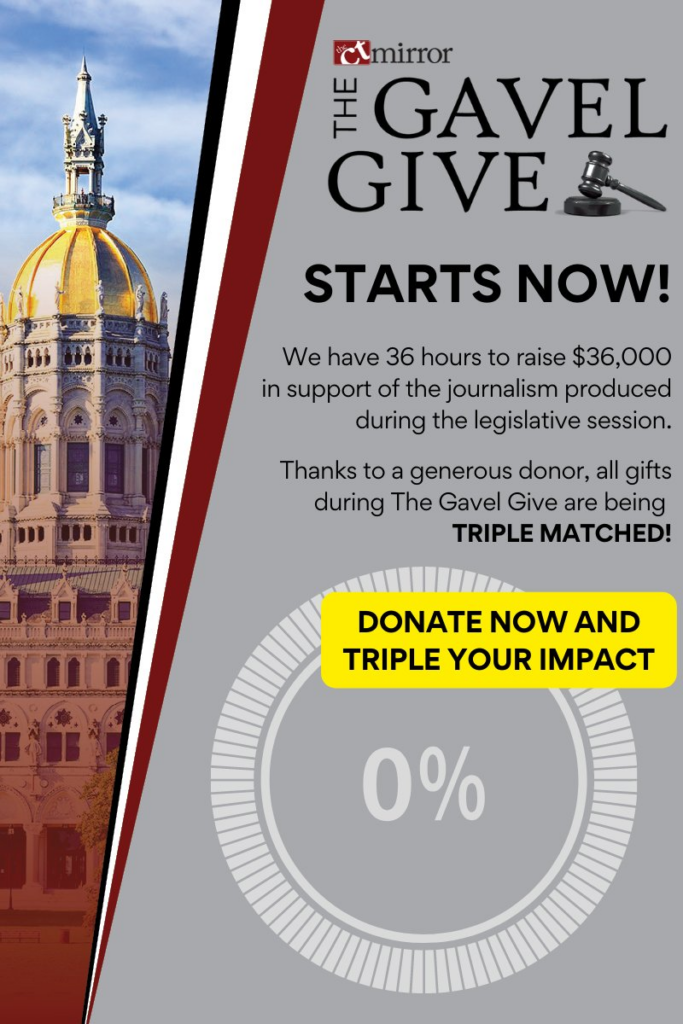


A dynamic progress bar also sat at the top of CT Mirror’s homepage throughout the fundraiser, yet another touchpoint for readers to learn about the challenge.
CT Mirror first introduced The Gavel Give in 2021. Their goal was to raise $30,000; they raised $32,339. In 2022, they increased their goal to $36,000. They raised $39,186.
The results
In 2021, 306 readers contributed to the campaign, including 67 people who were new CT Mirror donors. In 2022, 283 donors contributed to Gavel Give, including 72 new donors — a little over 25% of all donors. The majority of Gavel Give gifts are one-time donations.
Almost 100 people unsubscribed from CT Mirror’s mailing list during the 2022 campaign. “Do we hate to see them go? Of course,” Constable shared. “But if a hundred people off the email list means $40,000 in new revenue, I’m going to take that trade-off every day of the week.”
Constable also created a way for newsletter subscribers to skip Gavel Give emails. Starting with the 48-hour preview, all campaign messages include a clear opt-out message and link in the footer. The message read: “Already donated or want to opt out of Gavel Give emails? Update your preferences to skip these emails specifically.” Around 100 readers took advantage of that option.
This isn’t the only time that CT Mirror fundraises. Constable said that The CT Mirror has a “mindset of constant campaigning.” They send out regular donation-request emails that feature standout stories and other newsroom updates, participate in NewsMatch, and look for other fundraising campaign opportunities throughout the year.
“So much of the fundraising mentality is about the long-run,” Constable explained. “We’ll take the $10 monthly donor over the one-time $100 gift, because after 12 months, it’s gonna be $120 instead of $100 and so on.”
With The Gavel Give, though, they can activate a different set of potential donors, ones who might not ever become a recurring supporter. “Different people respond to different things,” Constable added. “The Gavel Give helps us tap into those readers who get caught up in the energy of the moment and make that financial gift.”
In the end, it’s all about balance. The combination of steady membership program growth, the end-of-year NewsMatch campaign, and The Gavel Give creates “a solid blueprint for the year,” he explained.
What they learned
Build your mailing list. Constable credits much of the success of The Gavel Give to “the constant work that we are doing to grow our email newsletter list.” That work includes regularly refreshing calls-to-action, or CTAs, on CT Mirror’s website and launching new newsletters. “If we were not always adding new people to our email list, then we would have no new donors,” Constable explained.
Create a sense of urgency. By announcing a goal to reach within a certain timeframe and offering a triple match for donations made during that period, there’s palpable excitement. And through progress-bar graphics, emails from reporters and editors, and social posts, the newsroom constantly reminds readers of the goal, the deadline, and how close they are to both of those things. “The more you can create the feeling that this is an event,” Constable explained, “the more successful it’s going to be.”
Identify room for improvement. Constable and the CT Mirror team always take time after a campaign like The Gavel Give to reflect on how the fundraiser went and what they could improve next time. During the retrospective meeting, the staff discusses what worked and what didn’t; how the fundraiser felt workload-wise; whether they hit their revenue goal; and what they could do differently next year. One takeaway from 2021 was how successful the Gavel Give countdown-timer-turned-progress-bar performed on their homepage. In 2022, after CT Mirror relaunched its site, Constable’s first priority was to rebuild that bar for the next campaign.
Key takeaways and cautionary notes
Be prepared. Creating all of the campaign assets ahead of time makes a huge difference. In the weeks leading up to The Gavel Give, Constable crafts emails, designs campaign graphics, and streamlines as many processes as possible. “At the end of the day, The Gavel Give campaign is a ridiculous amount of emails in a very short amount of time, and to create each and every one of those emails takes time,” Constable said. “But if you can find ways to increase efficiency, then you’ve got a winner.”
Be aggressive. Sending eight fundraising emails in two days is a lot, but it’s part of running a successful deadline-driven campaign. Overall, Constable’s been surprised how receptive most readers are to the volume of messages during The Gavel Give. “It’s not that you can’t send too many emails; you can but you can send a lot more emails than you think you could before you’ve sent too many emails,” he said.
Be yourself. Constable said that most newsrooms can find campaign opportunities. “You know what your big moments are in the year,” he offered. “You don’t have to overthink it. Just go where your readers are and build something around the natural momentum.”
Other resources
- News Revenue Hub, case study: Over $36,000 in 36 hours: Behind the CT Mirror’s hallmark fundraiser
- CT Mirror, example tweet: THE GAVEL GIVE IS UNDERWAY!
- CT Mirror, additional appeals:


